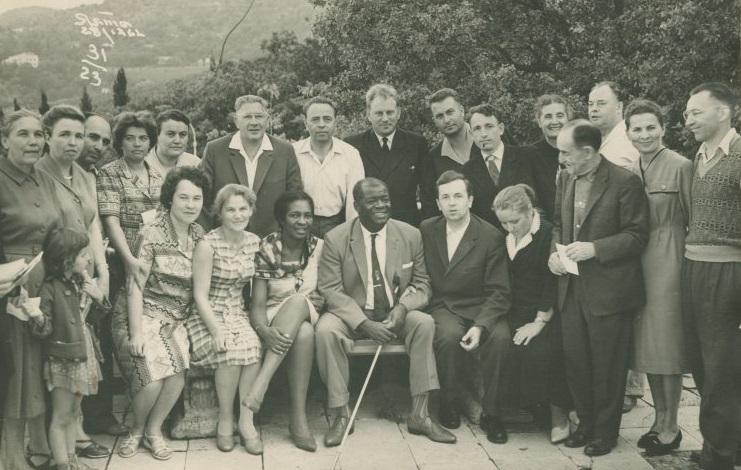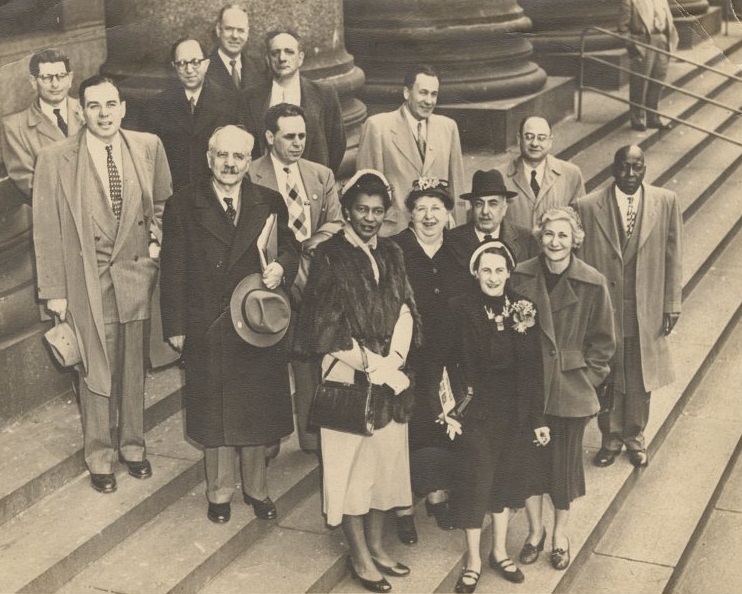Claudia Jones and Ending the Neglect of Black Women

With the onset of the Cold War and the U.S. government’s attacks on radicalism, the American Communist Party began to reassess its priorities in the late 1940s. Claudia Jones chose this moment to draw the Party’s attention to its neglect of Black women’s issues. Despite the Party’s anti-racist and anti-sexist commitment, Party leaders left women’s issues to women members while the Party’s commitment to Black self-determination weakened in the face of Cold War scrutiny. Jones used the internal debate as an opportunity to commit the Party to focusing on Black women’s class, race, and gender oppression. The publication of her 1949 article “An End to the Neglect of the Problems of the Negro Woman” propelled Jones to leadership in the Party, changed the Party’s focus on women’s issues, and made Jones a pioneer thinker in intersectional feminism.
Black women’s unique oppression was an issue long discussed in civil rights and Black nationalist movements and described by many names, including ‘double jeopardy,’ Jane Crow, triple exploitation, or triple oppression. The educator Anna Julia Cooper wrote at length about Black women’s gendered and racialized experience with oppression. Amy Jacques Garvey, Marcus Garvey’s second wife, wrote several articles in the Negro World about the need to dismantle the gender-neutral approach to anti-racism. Women in the American Communist Party emphasized that class could not be excluded in examinations of Black women’s experience in the United States. Erik S. McDuffie credits communist Louise Thompson with coining the phrase triple oppression. But Carole Boyce Davies argues it was Claudia Jones who popularized the idea. It was Jones’ article on the Party’s neglect of Black women that synthesized the ideas about triple oppression that she had been writing and speaking about for years. What scholars have ignored is that in Jones’ written work on Black women’s oppression, she articulated an emancipatory politics for all. In her framework, the liberation of the most oppressed–Black women–would mean the liberation of everyone.
Jones argued in her article, that somehow, progressives, labor activists, and Leftists were ignorant of Black women’s militancy; meanwhile, the bourgeoisie was both aware and afraid of it. The reason was that when Black women “undertake action,” then the militancy of all Black people was “greatly enhanced.” This was rooted in Black women’s historical experience as the “guardian, the protector” of the Black family, and her experience in shielding her family from slavers, the “blows of Jim-Crow,” and in rearing children in a world with “lynch terror, segregation, and police brutality.” Jones argued that this oppression intensified in the postwar period as capitalists and the bourgeoisie celebrated American women’s equality. For Black women and working-class women, these boasts were hollow, and Black women faced “Not equality, but degradation and super-exploitation.” She warned that the result would be an uprising of Black women and a new more powerful militancy.

Black women—“as workers, as Negroes, and as women”—were “the most oppressed stratum” in the United States. Jones laid out the economic exploitation of Black women and the different treatment of Black and white women in the workforce, a point she wanted the Party to understand. She argued that Black women were compelled to work to make up for the low wages of Black men; meanwhile, white women did not face that same imperative. And when white women did enter the labor market, their wages were significantly higher than Black women’s. Black women’s “super-exploitation” led to a “virtual” iron-curtain “hemming in the lives of Negro Children” and undermining the health and well-being of the entire Black family. Jones indicted popular culture as a mechanism in constructing the mythology of the traditional “mammy,” content in her role as a caretaker of others. Jones insisted that it had to be “combatted” as a “device of the imperialists” and “white chavunists” that perpetuated the notion that Black women were “backward, inferior, and the natural slave of others” and handicapped them in the workforce.
Jones drew on history to argue that Black women had long been responsible for the care of Black families. From the burden that their children followed their status as slaves, and the need to care for children alone, slavery compelled women to maintain a level of authority that was a threat to patriarchy. After emancipation, Black men asserted their patriarchal rights, partly to protect women from the assaults of white men, and partly because he had been powerless before. The church helped to confirm male authority in the household, and Black women were expected to comply. But the need for Black women to work and help support their families meant that they were compelled to be active in the “economic, social, and political” life of the Black community. Women’s organization was beyond “charity” and instead focused on providing social services denied the Black family because of the “Jim Crow lynch system.”
After describing Black women’s triple oppression, Jones focused the remainder of her article on admonishing the Party for ignoring the organization and leadership abilities of Black women, and on its “white chavunism” on social issues within the Party. She argued that unions had to focus on organizing Black women in industry because they were treated with “special severity,” and that unionists needed to organize domestic workers who face “unbearable misery” and exploitation. At Party functions, white men and women and Black men participated in dancing but excluded Black women. And when Black women were included it was because they displayed “white ruling-class standards of ‘desirability,’” like light skin. Jones argued that political equality meant nothing without social equality and for Party members to “draw the line” at social intercourse and intermarriage was an example of “bourgeois-liberal thinking.”

Jones accused the Party of adopting the same social attitudes that perpetuated racism. She believed that the emphasis on the “battle of the sexes” meant that liberals and leftists could ignore the primary conflict for both Black men and women, that they shared a common oppressor – the “white ruling class.” By gendering social relationships and reifying beliefs in gender difference, the Party, like American culture, could ignore its own racism.
Jones also took issue with what we would today call microaggressions – paternalistically acting surprised when a Black woman was a professional, asking a Black comrade if they had a family member that might want to work as a domestic, and a host of other racist behavior that alienated Black women and men in the Party. Jones exposed the hypocrisy of those on the “Progressive-left” who would push for political equality and simultaneously ignore their own racism.
In perhaps her most controversial claim of the article, but also the most important, Jones argued that in “developing consciousness” on women’s issues, the Party had to understand that the “Negro question…is prior to, and not equal to, the woman question.” Here, Jones articulated an emancipatory theory that focused not simply on Black women, but on all women, and by extension, everyone. She argued that the progressive women’s movement had to focus on Black women’s emancipation, because she combined the status of worker, Black, and woman, and could foster a “heightened political consciousness.” If the Party’s goal was to achieve a “Socialist America”—which was the “final and full” guarantee of women’s emancipation, it could neither ignore Black women’s oppression, nor their potential as leaders.
The recognition of Black women’s triple oppression and her historical resistance to that oppression required the Party and all progressives to make room for Black women’s leadership. They were essential in the “anti-fascist, anti-imperialist” coalition against “Wall Street imperialism.” Black women, with their heightened consciousness, had to be the “vanguard of the working class.” Jones believed that only by emancipating the most oppressed would a “full equality and dignity” be achieved in a socialist America. In ending the neglect of Black women, the Party, and American society, could finally achieve a genuine equality for all.
Copyright © AAIHS. May not be reprinted without permission.